Your cart is currently empty!

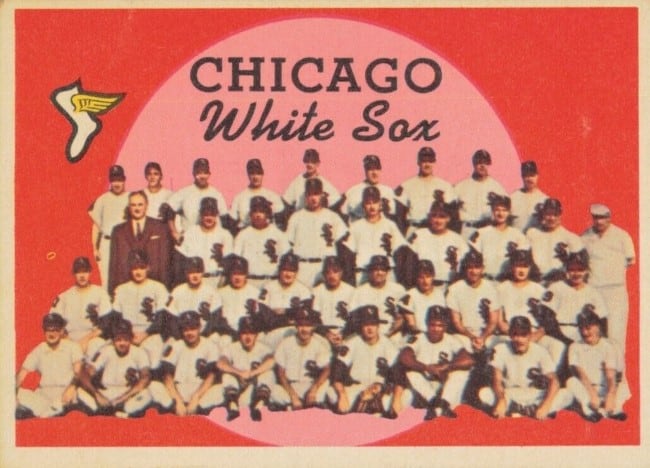
The Chicago White Sox were established in 1901 as one of the American League’s original eight charter franchises. The team has over 120 years of history, many of them reflected in White Sox cards.
Initially christened the Chicago White Stockings, the team played its early seasons at South Side Park. However, in 1910, they relocated to the iconic Comiskey Park. This move would become synonymous with the team’s identity for much of its existence. The name underwent a simplification in 1903, becoming the name we know today – the Chicago White Sox.
The White Sox quickly asserted themselves as formidable contenders in the American League, clinching their first championship in 1906. A second World Series championship followed in 1917. This is particularly noteworthy because the White Sox triumphed during a tumultuous period in American history, amidst World War I and the Spanish flu pandemic.
However, the team’s narrative is not solely characterized by championship glory. The White Sox also found themselves ensnared in the throes of one of baseball’s most infamous incidents—the Black Sox Scandal of 1919. Eight members of the team were accused of intentionally losing the World Series for the benefit of gamblers. This led to lifetime bans from the sport for each implicated player. The scandal left an indelible stain on the franchise’s history. It also serves as a cautionary tale about the potential pitfalls of corruption within the world of professional sports.
Throughout the ensuing decades, the White Sox experienced a mix of highs and lows. The mid-20th century witnessed the emergence of the “Go-Go Sox,” a moniker attributed to the 1959 team that secured the American League pennant but fell short in the World Series. This era showcased the team’s resilience and competitiveness, even in the face of ultimate disappointment.
The turn of the 21st century brought renewed success to the White Sox, culminating in their 2005 championship. This victory, after an 88-year championship drought, solidified the team’s place in baseball lore. That squad, led by a talented roster, provided a fitting bookend to decades of longing for championship glory.
Despite these accomplishments, the White Sox, like many teams, have weathered periods of adversity. Notably, the team endured a prolonged postseason absence between 1959 and 1983. The stretch was punctuated by near-misses and fleeting glimpses of contention. Such periods of struggle serve as a testament to the cyclical nature of success in professional sports.
The Chicago White Sox storied past serves as a foundation for the ongoing pursuit of excellence. From the early glory days of the 1906 championship to the triumphs and trials of subsequent decades, the White Sox’s journey reflects the enduring spirit and resilience inherent in the world of America’s favorite pastime.
10. Ray Schalk
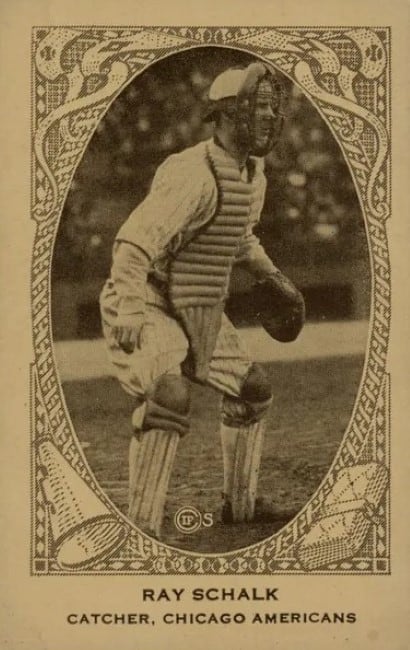
Ray Schalk etched his name in baseball lore with his exceptional skills as a defensive catcher. Schalk played all but five games of his career with the White Sox, from 1912-1928. During his tenure, he became renowned for his ability to handle pitchers. He also framed pitches effectively and thwarted baserunners with his cannon-like arm.
Schalk was a key part of the 1917 White Sox team that won the World Series championship. Two years later, the Black Sox Scandal threatened baseball. When Schalk’s teammates conspired to throw the 1919 World Series, Schalk – known for his ethics – did not take part. In fact, he played his heart out, hitting .304 in a losing effort.
Schalk was called a “workhorse” and the “finest defensive catcher of the Deadball Era.” However, he credited his pitchers with his success. Schalk also caught four no-hitters in his career, and he served as team captain for several seasons. He finished his offensive career with 1,345 hits and a .253 batting average. He also placed in the top 10 of MVP vote-getters in 1914 – at age 21 – and 1922.
Ray Schalk entered the Baseball Hall of Fame in 1955.
Best White Sox card: 1922 American Caramel Series E120 Ray Schalk
Ray Schalk has a surprising number of baseball cards, given the time period in which he played. However, many of them do repeat the same photo over a period of several years. The American Caramel set, which has an ornate border encircling a black and white photo, is his best. This White Sox card is typically found at PSA 4 or below, and costs approximately $50-$100 in those conditions.
9. Minnie Minoso
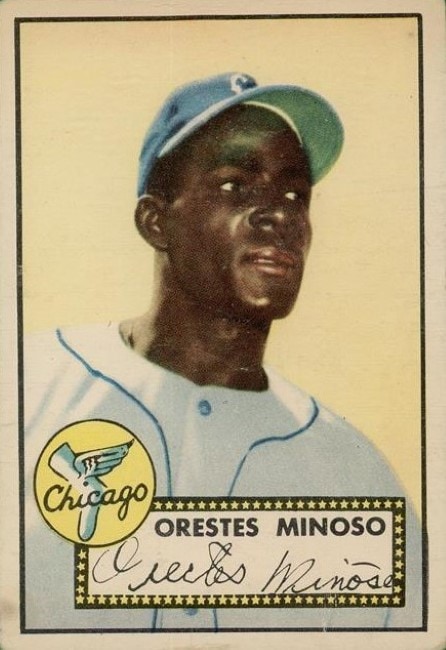
Minnie Minoso, born Saturnino Orestes Armas Miñoso Arrieta was a five-tool player known for his versatility. Minoso played for the White Sox in three separate decades—1951-1957, 1960-1961, and 1964-1976. His electrifying presence on the field earned him five All-Star selections and two Gold Glove Awards with the White Sox. Renowned for his speed, he led the AL in triples three times and stolen bases three times with the Sox. He also finished in the top 10 of MVP voting five times.
A cornerstone of the White Sox lineup, Minoso played a pivotal role in the team’s success. Although a World Series championship eluded him during his playing days, his impact on the franchise was undeniable. He was the first black player in White Sox history and one of the earliest Latino stars in Major League Baseball. According to Hall of Famer Orlando Cepeda: “Minnie Minoso is to Latin ballplayers what Jackie Robinson is to black ballplayers.”
Minnie Minoso posthumously entered the Baseball Hall of Fame in 2022.
Best White Sox card: 1952 Topps Minnie Minoso (Orestes Minoso) #195 (RC)
Minoso didn’t appear in the 1951 sets, so this rookie is his first in a White Sox uniform. (He had previously played in the Negro Leagues and the Mexican League before debuting in MLB). The card lists him as “Orestes Minoso” and has a bright yellow background. Up to PSA 7, the card is an affordable $200 or less. Beyond that, the card can cost several thousand dollars in top condition.
A 2001 Topps Heritage autographed version (#THA-MM) is also available.
8. Billy Pierce
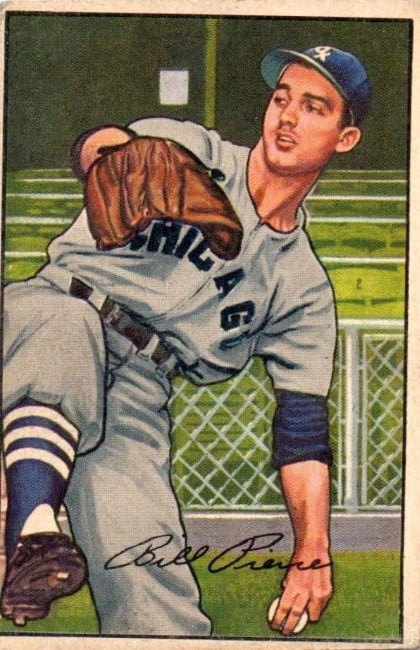
Billy Pierce, a left-handed pitching stalwart for the Chicago White Sox from 1949 to 1961, is one of the franchise’s greatest hurlers. A seven-time All-Star during his tenure with the White Sox, Pierce was known for his remarkable control and strikeout ability. His standout season came in 1956 when he won 20 games, contributing significantly to the Sox’s AL pennant that year. Pierce led the league in strikeouts in 1953. In 1955 he posted a career-best 1.97 ERA, showcasing his dominance on the mound.
Pierce also played a crucial role in the White Sox’s journey to the 1959 World Series. Although they fell short against the Los Angeles Dodgers, Pierce pitched four scoreless innings in relief to help his team. Over his career, he also had a bitter rivalry with fellow left-hander Whitey Ford, who he faced 14 times between 1955-1960.
A reliable and consistent pitcher, Pierce recorded 186 victories during his time with the White Sox. He is among the franchise’s all-time leaders in wins. Pierce also briefly worked as a White Sox broadcaster after his playing career. This enabled him to maintain his connection to the organization and further endeared him to fans.
Pierce is not a member of the National Baseball Hall of Fame but the White Sox retired his number 19 jersey in 1987.
Best White Sox card: 1952 Bowman Billy Pierce #54
Pierce is a rarity among players from the pre-Topps era: He only appeared on one trading card before 1951 (the 1947 Exhibits W461). From 1951 and beyond, he was a mainstay on baseball cards. His best White Sox card is the 1952 Bowman, which shows a full-color illustration of the southpaw rearing back to throw, wearing his road-gray uniform. Unless you’re looking for a low-pop PSA 9 or PSA 10, this card is readily available for around $50.
7. Red Faber
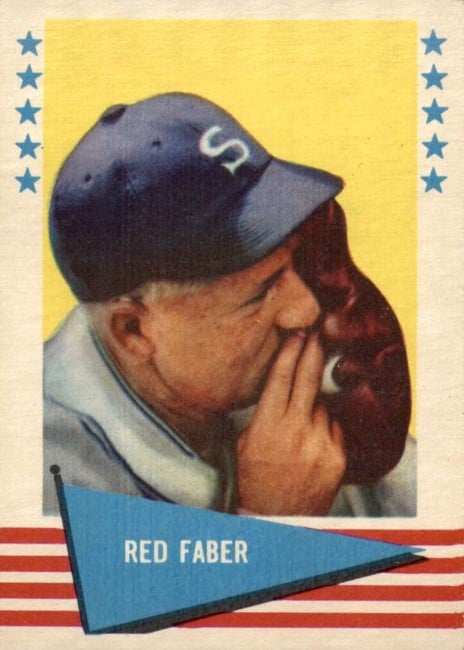
Urban Clarence “Red” Faber was a prominent pitcher for the Chicago White Sox during the Deadball Era and into the early years of the lively ball period. Born on September 6, 1888, he spent his entire 20-season Major League Baseball career with the White Sox, from 1914 to 1933.
As a key member of the White Sox rotation, Faber contributed significantly to the team’s success, especially during their historic 1917 championship season. He threw 27 innings and won three games in the series against the New York Giants. Faber was also a key contributor to the White Sox’s three AL pennants in the 1910s.
Red Faber had impressive control and a repertoire of pitches that included a spitball – a pitch that later became illegal but was a formidable weapon during his playing days. When the spitball was banned, Faber was “grandfathered in” and ultimately he was the last pitcher to throw a spitter in the American League.
Throughout his career with the White Sox, Faber accumulated 254 career victories and 29 shutouts, and he surpassed the 20-win mark four times during his career. In 1921 and 1922 – his best seasons – Faber led the league in complete games, ERA and WHIP.
Faber entered the Baseball Hall of Fame in 1964.
Best White Sox card: 1961 Fleer Red Faber #24
It’s rare that we choose a White Sox card from outside a player’s active years, but this one is worth the exception. Faber, known as a spitballer, is brilliantly depicted in the landmark 1961 Fleer set putting the ball to his mouth. This set is full of Hall of Famers, and Faber himself was inducted three years later. The card can be purchased for around $10 in ungraded condition.
If you’d like a card from Faber’s playing days, we recommend the 1933 Goudey #79. While this is technically his rookie card (i.e. the first mainstream baseball card featuring Faber), it’s actually from his last season. You can find this card in ungraded condition for around $50-$150.
6. Nellie Fox

Born on December 25, 1927, Jacob Nelson Fox (“Nellie”) was a gifted second baseman and an integral part of the White Sox infield during the 1950s and early 1960s. Known for his exceptional defensive skills and scrappy style of play, Fox became a fan favorite and a symbol of consistency for the White Sox.
Fox’s offensive prowess was evident throughout his career with the White Sox, earning him numerous accolades. He led the American League in hits four times (1952, 1954, 1957, 1958). He also consistently maintained a high batting average, finishing his career with a .288 mark. Known as a “tough out,” Fox struck out only 216 times in 10,351 plate appearances, a statistic nearly unheard of in the sport.
The pinnacle of Nellie Fox’s White Sox career was the 1959 season. The team, dubbed the “Go-Go Sox,” was a scrappy, clutch, speedy team that won the American League pennant (although the team ultimately lost the World Series to the Los Angeles Dodgers in six games). For the year, Fox won the American League MVP award, batting .306 with 191 hits. He also displayed exceptional defensive skills, winning one of his three Gold Gloves.
Nellie Fox entered the Baseball Hall of Fame in 1997.
Best White Sox card: 1951 Bowman Nellie Fox #232
Fox debuted in 1947, but the 1951 Bowman is Nellie Fox’s first mainstream card. This set is a collector’s favorite. The Fox portrait – he’s credited as Nelson Fox – has great colors and composition. The price of the card is very condition dependent, ranging from $100-$200 for a PSA 4 or PSA 5, to over $1,000 for a PSA 8 or more. (There is only one known PSA 10 in existence, which sold for over $13,000.)
5. Ted Lyons
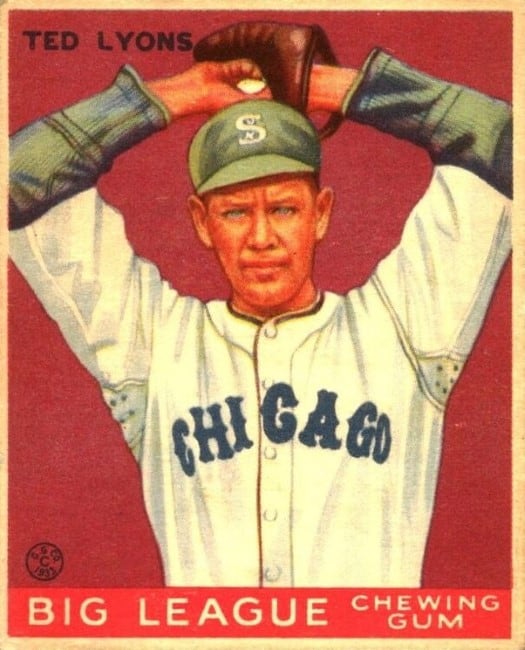
Ted Lyons became synonymous with the Chicago White Sox during his remarkable 21-season career with the team from 1923 to 1942 and a brief return in 1946. Born on December 28, 1900, Lyons was a durable and consistent force on the mound, earning him the nickname “Sunday Teddy” due to his penchant for pitching on Sundays.
Lyons had excellent control and a talent for inducing ground balls. He led the league in innings pitched twice during his career, in 1927 and 1930. He also led the league in complete games during those two seasons. In 1927, he no-hit the Red Sox in just one hour, seven minutes.
Lyons had outstanding longevity in the sport. He pitched actively for 21 years. He then took an additional three years away from baseball to fight in World War 2 during his age 42-44 seasons. His longevity came, in part, from his ability to reinvent himself. As a 22-year-old rookie fireballer, Lyons relied on overpowering hitters; however, as his career progressed, he began changing speeds more and using pitches with more movement.
His dedication to the White Sox organization was evident in his decision to stay with the team through thick and thin, even during challenging periods. Although team success in terms of championships eluded Lyons during his playing days, his impact as a reliable and respected pitcher was immeasurable. Lyons also served as manager for three seasons, and later as a scout for the organization.
Ted Lyons entered the Baseball Hall of Fame in 1955.
Best White Sox card: 1933 Goudey Ted Lyons #7
The Goudey set is a classic on its own, but this Ted Lyons White Sox card is incredible even by Goudey standards. The card shows Lyons in mid-windup. The detailed stitching and panels of his uniform stand out, along the dark “Chicago” name on his jersey, as he stares directly at the viewer with his steely-blue eyes. Who wouldn’t be afraid to stand in the box against him? Expect to pay around $200-$400 for a mid-grade version.
4. Eddie Collins
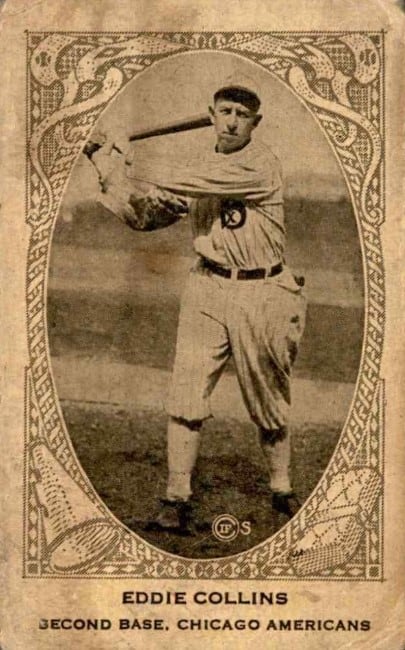
Eddie Collins, a legendary second baseman, played for the Chicago White Sox from 1915 to 1926. Collins played a crucial role in the White Sox’s triumph in the 1917 World Series, a year often remembered as one of the most successful in franchise history. His stellar performance in the postseason, including a .409 batting average in the World Series against the New York Giants, helped secure the White Sox’s second championship.
Offensively, Collins was a force who finished his career with a remarkable .333 batting average. He had 10 straight seasons where he hit over .340, and he led the league in stolen bases four times during his tenure with the White Sox. Collins is one of only five players in history with more than 500 steals and a .400 on-base percentage. He was also one of the first players in history to reach the 3,000 hit mark. He still holds the record for most games played at second base (2,650).
Collins had a reputation as a smart ball player, having attended Columbia University. In addition to his contributions on the field, Collins was player-manager for the White Sox from 1924-1926, compiling a winning percentage of .521.
Eddie Collins was inducted into the Baseball Hall of Fame in 1939.
Best White Sox card: 1922 Neilson’s Chocolate Eddie Collins #29
Many of Eddie Collins’s most famous cards (like the T205 and T206) show him in an Athletics uniform. His best White Sox card is the 1922 Neilson’s Chocolate Eddie Collins #29. The card has an ornate black and white border around a photo of Collins swinging his bat. Collins’ card isn’t easy to find, and costs approximately $300-$500 in poor condition.
3. Luke Appling
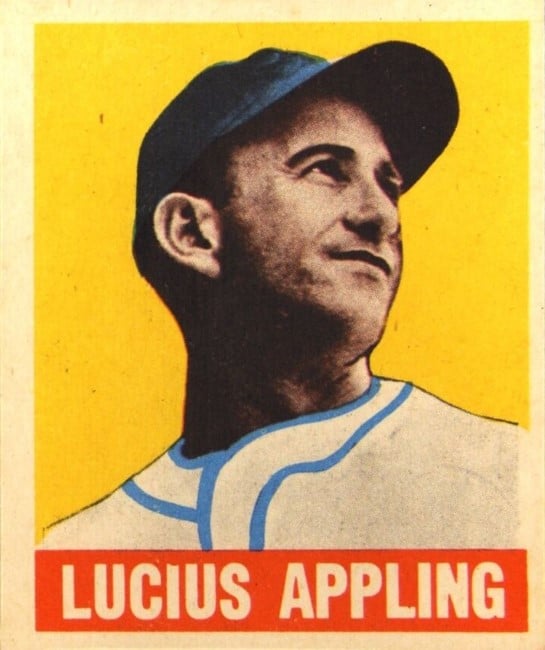
Luke Appling, the legendary shortstop, had a 20-season career with the White Sox from 1930 to 1950. Born on April 2, 1907, Appling’s defensive prowess, consistency at the plate, and longevity made him one of the most iconic players in franchise history. Throughout his tenure, Appling became synonymous with the shortstop position and was a beloved figure among White Sox fans.
Appling holds the White Sox record for games played (2,422) and hits (2,749). He finished his career with a .310 batting average, which is top 10 all-time for the franchise. He also has the most offensive WAR of any White Sox position player, and he’s 4th all-time in defensive WAR in franchise history. Appling also once held the MLB record for most games played by a shortstop – a mark that was eventually beaten by fellow Sox legend Luis Aparicio.
One of the standout moments in Appling’s career came in 1943 when, at the age of 36, he won the American League batting title with an impressive .388 average. This remarkable accomplishment highlighted his ability to maintain a high level of play well into his 30s. Appling’s offensive contributions were not limited to batting average; he also displayed discipline at the plate, leading the league in walks four times during his career.
Appling is known for committing a staggering 643 errors in his career; however, much of this was due to his range and speed, which allowed him to reach balls that most shortstops couldn’t get a glove on. He had the endorsement of many of his contemporaries, including pitcher Eddie Lopat, who commented: “He was the finest shortstop I ever saw. In the field, he covered more ground than anyone in the league.”
While Appling never brought home a championship for the White Sox, he made a significant impact with the team. He was a seven-time All-Star and was twice a runner-up for MVP (1936 and 1943). Appling’s influence went beyond his playing days, as he later managed the White Sox from 1951 to 1953.
Luke Appling entered the Baseball Hall of Fame in 1964.
Best White Sox card: 1948 Leaf Lucius “Luke” Appling #59
Let’s get the obvious question out of the way first: Appling doesn’t have a true rookie card. He debuted in 1930 and his first card is from the 1934 Goudey. For that reason, his rookie card is not that compelling. However, the 1948 Leaf card is – it features groundbreaking photography and printing (for the time period) with a sepia photo that’s been boldly colorized on the background, jersey and cap. This late 40s style is instantly recognizable. The card sells around $200-$600 in near-mint, graded condition. At low grades you can purchase one for around $20-$25.
2. Ed Walsh
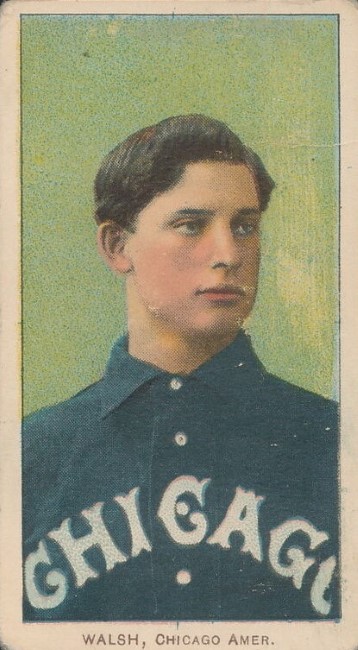
“Big Ed” Walsh was one of the most dominant pitchers of his era. Spending all but four games of his career with the White Sox from 1904 to 1916, Walsh became a symbol of excellence on the pitcher’s mound. This was highlighted by a remarkable 1908 season where he set the record for the lowest earned run average (ERA) in a single season, an astonishing 1.42 – a record that still stands to this day. This remarkable achievement contributed significantly to the White Sox’s push for the pennant that year. He still holds the MLB record for lifetime ERA (1.82) and FIP (2.02).
Walsh’s pitching propelled the White Sox to their first World Series appearance in 1906. He played a pivotal role in securing the championship by winning two crucial games against their crosstown rivals, the Chicago Cubs, with only 1 earned run in 15 innings pitched, including a shutout.
In addition to his remarkable 1908 season, Walsh consistently delivered outstanding performances throughout his tenure with the White Sox. He led the American League in strikeouts twice and was a key contributor to the team’s success in various pennant races. Despite playing in an era where pitcher workloads were substantial, Walsh’s durability was evident. He frequently exceeded 300 innings pitched in a season five times, including a league-leading 464 innings in 1908.
Ed Walsh’s contributions to the White Sox did not go unnoticed, as he received numerous accolades during his career. He was a two-time ERA champion, a two-time strikeout leader, and a Triple Crown winner in 1908. Walsh’s excellence on the mound earned him a spot on two All-Star teams before the advent of the official All-Star Game.
Ed Walsh entered the Baseball Hall of Fame in 1946.
Best White Sox card: 1909-1911 T206 Ed Walsh White Border
Although he appeared in all of the popular sets of his time, Ed Walsh’s T206 card stands out for the deep, rich blue color of his jersey against the green background. As with all cards of this era, condition is a strong indicator of price, but even in PSA 8 condition the card is surprisingly affordable at around $5,000-$10,000 (“affordable” meaning: “Not a T206 Honus Wagner“). At low grades, you can own one for $300-$500.
1. Frank Thomas
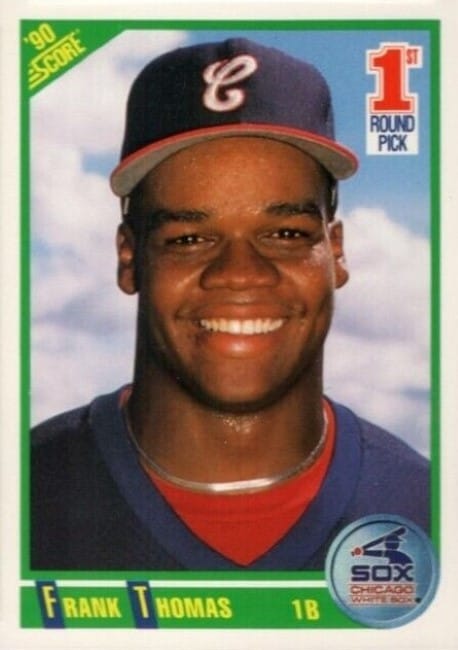
Frank Thomas, widely known as “The Big Hurt,” stands as one of the most iconic figures in the history of the Chicago White Sox. His imposing presence at the plate, combined with exceptional hitting ability, made him a force to be reckoned with during his illustrious career with the White Sox from 1990 to 2005. Thomas played a pivotal role in transforming the White Sox into a competitive force in the American League at the turn of the 21st century.
The cornerstone of the White Sox’s lineup for over a decade, Thomas won back-to-back American League MVPs in 1993 and 1994, one of only six American League players to win the award consecutively. He finished in the top 10 of MVP voting six other times with the White Sox, and his power at the plate earned him four Silver Slugger Awards, further emphasizing his dominance as one of the premier hitters in the league. He described himself as having the “size and the strength of a football player playing baseball.”
Thomas became the first player in White Sox history to hit 400 home runs, solidifying his status as the franchise’s all-time home run leader. He hit 30+ home runs in a season eight times with the White Sox, finishing his MLB career with 521 home runs. Thomas was also instrumental in leading the White Sox to several playoff appearances, including their memorable run to the American League Championship Series in 1993. He won a World Series with the White Sox in 2005, although he did not play due to injury.
Frank Thomas entered the Baseball Hall of Fame in 2014.
Best White Sox baseball card: 1990 Score Frank Thomas #663 (RC)
Frank Thomas had almost a dozen rookie cards in various forms (Tiffany, update, oddball) but this one wins because it’s a beautiful card. Thomas is pictured in a portrait, smiling, and you can see so much potential and the hints of the slugger he would become. This card sells in the $25-$50 range for an ungraded version.
Honorable mention goes to the 1990 Topps #414 No Name card, which is a highly-coveted error card. Thomas is shown in his Auburn baseball uniform and the card features a blue banner on the front of the card, as usual, but his name is missing. This is one of Thomas’s most sought-after cards, especially for error-card collectors.
Tags:
Share:
